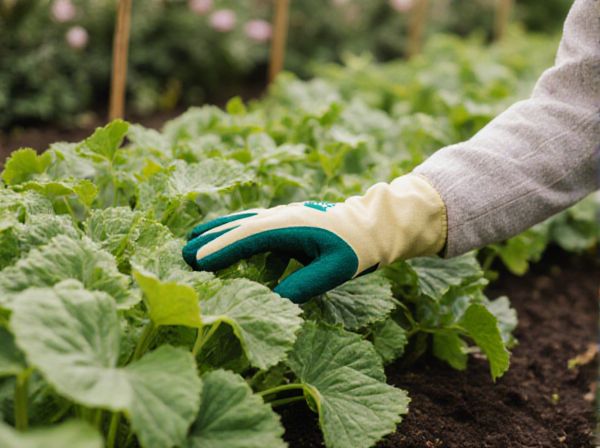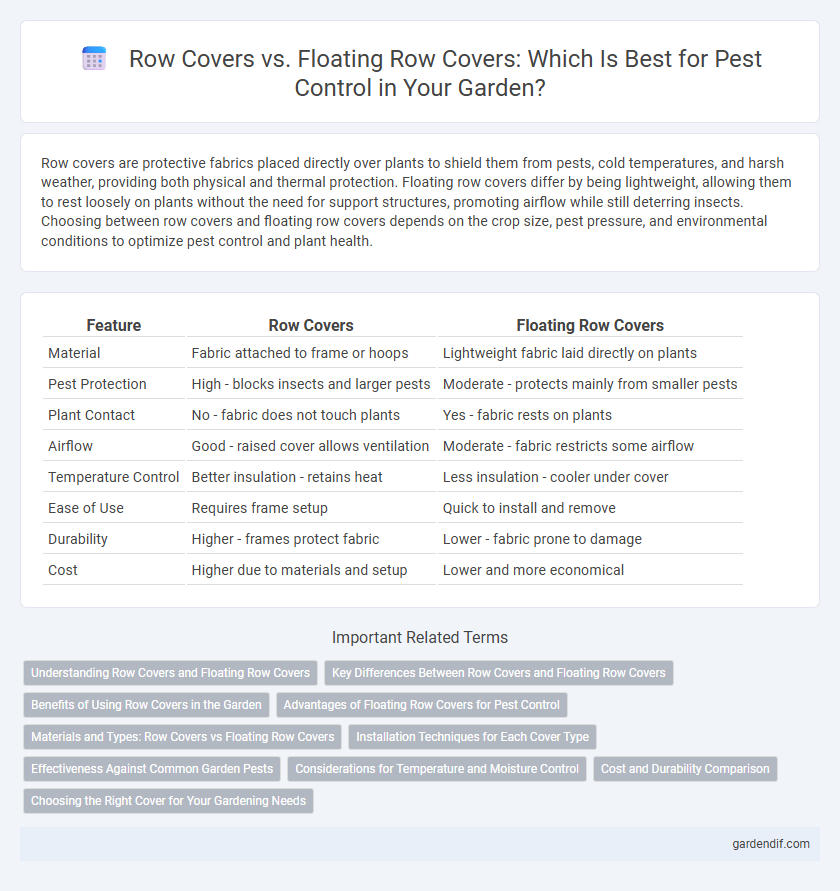
row covers vs floating row covers Illustration
Row covers are protective fabrics placed directly over plants to shield them from pests, cold temperatures, and harsh weather, providing both physical and thermal protection. Floating row covers differ by being lightweight, allowing them to rest loosely on plants without the need for support structures, promoting airflow while still deterring insects. Choosing between row covers and floating row covers depends on the crop size, pest pressure, and environmental conditions to optimize pest control and plant health.
Table of Comparison
| Feature | Row Covers | Floating Row Covers |
|---|---|---|
| Material | Fabric attached to frame or hoops | Lightweight fabric laid directly on plants |
| Pest Protection | High - blocks insects and larger pests | Moderate - protects mainly from smaller pests |
| Plant Contact | No - fabric does not touch plants | Yes - fabric rests on plants |
| Airflow | Good - raised cover allows ventilation | Moderate - fabric restricts some airflow |
| Temperature Control | Better insulation - retains heat | Less insulation - cooler under cover |
| Ease of Use | Requires frame setup | Quick to install and remove |
| Durability | Higher - frames protect fabric | Lower - fabric prone to damage |
| Cost | Higher due to materials and setup | Lower and more economical |
Understanding Row Covers and Floating Row Covers
Row covers and floating row covers serve as physical barriers protecting plants from pests, temperature extremes, and harsh weather conditions; traditional row covers require support structures such as hoops or frames to hold the fabric above plants, ensuring proper airflow and growth space. Floating row covers differ by laying directly over crops without the need for supports, allowing lightweight fabric to drape naturally while still offering pest exclusion and frost protection. Both types typically use spunbonded polyester or polyethylene materials, with floating row covers favored for their ease of installation and flexibility in covering irregularly shaped areas.
Key Differences Between Row Covers and Floating Row Covers
Row covers are fabric panels stretched and secured over crops using frames or hoops, providing protection from pests, frost, and harsh weather, while floating row covers lay directly on plants without support structures, allowing for more flexibility and ease of installation. Floating row covers enhance airflow and light penetration due to their lightweight design, making them ideal for delicate crops and short-term use, whereas traditional row covers offer sturdier protection for longer durations and larger plants. Key differences include installation methods, level of support, airflow, and suitability for varying crop types and pest control needs.
Benefits of Using Row Covers in the Garden
Row covers provide an effective barrier against pests such as aphids, cabbage worms, and flea beetles, reducing the need for chemical pesticides and promoting organic gardening practices. Floating row covers enhance plant growth by creating a microclimate that retains heat and moisture, improving seed germination and extending the growing season. Both types help protect crops from harsh weather, minimizing damage from frost and strong winds while allowing light and water to penetrate.
Advantages of Floating Row Covers for Pest Control
Floating row covers offer superior pest control by creating a physical barrier that prevents insects from reaching plants while allowing sunlight, air, and moisture to penetrate. Their lightweight and flexible design enables easy installation directly over crops without the need for support structures, ensuring better coverage and protection. This method reduces reliance on chemical pesticides, promoting healthier plant growth and sustainable pest management.
Materials and Types: Row Covers vs Floating Row Covers
Row covers are typically made from woven or non-woven fabrics such as spunbonded polyester or polypropylene, providing durable protection against pests while allowing sunlight and moisture to penetrate. Floating row covers are lightweight, breathable fabrics like mesh or fine netting that float directly over crops without needing support structures, enabling easy access and flexibility. Both materials are selected based on pest management needs, with spunbonded fabrics offering stronger barriers and floating covers delivering gentle, adaptable coverage.
Installation Techniques for Each Cover Type
Row covers require anchoring the fabric securely using soil, pins, or staples along the edges to prevent pests from entering and to withstand wind. Floating row covers are draped directly over plants without a frame, relying on the plant's support and careful securing at the edges to allow for plant growth and easy access. Proper installation of both types involves ensuring complete coverage and tight sealing to maximize pest protection.
Effectiveness Against Common Garden Pests
Row covers provide a physical barrier that effectively prevents pests such as aphids, beetles, and cabbage worms from reaching plants, reducing damage without chemical intervention. Floating row covers, made of lightweight, breathable fabric, offer similar pest protection while allowing air, light, and moisture to pass through, promoting healthy plant growth. Both types significantly reduce infestations of common garden pests but floating row covers are often preferred for delicate crops due to their flexibility and ease of use.
Considerations for Temperature and Moisture Control
Row covers and floating row covers both offer effective pest protection, but differ significantly in temperature and moisture control. Floating row covers allow better air and moisture circulation, reducing humidity buildup and overheating, while traditional row covers tend to trap more heat and moisture, potentially stressing plants in warmer climates. Selecting the appropriate cover depends on the specific crop, local climate conditions, and desired balance between pest exclusion and environmental regulation.
Cost and Durability Comparison
Row covers typically offer a lower initial cost compared to floating row covers, making them budget-friendly for large-scale gardening or farming projects. Floating row covers, made from lightweight, flexible materials, provide enhanced durability by resisting tearing and lasting multiple growing seasons, which can offset their higher upfront price. Investing in floating row covers often results in longer-term savings through reduced replacement frequency and better pest protection.
Choosing the Right Cover for Your Gardening Needs
Choosing the right cover for your gardening needs depends on the level of protection and ease of use required; row covers provide sturdy physical barriers suitable for heavy pest infestations, while floating row covers offer lightweight protection that allows air, light, and water to reach plants without the need for support structures. Floating row covers are ideal for delicate crops and quick installation, enabling gardeners to protect plants from insects like aphids and beetles without hindering growth. For heavy-duty pest control or frost protection, traditional row covers with frames or hoops ensure maximum durability and insulation.
row covers vs floating row covers Infographic

 gardendif.com
gardendif.com